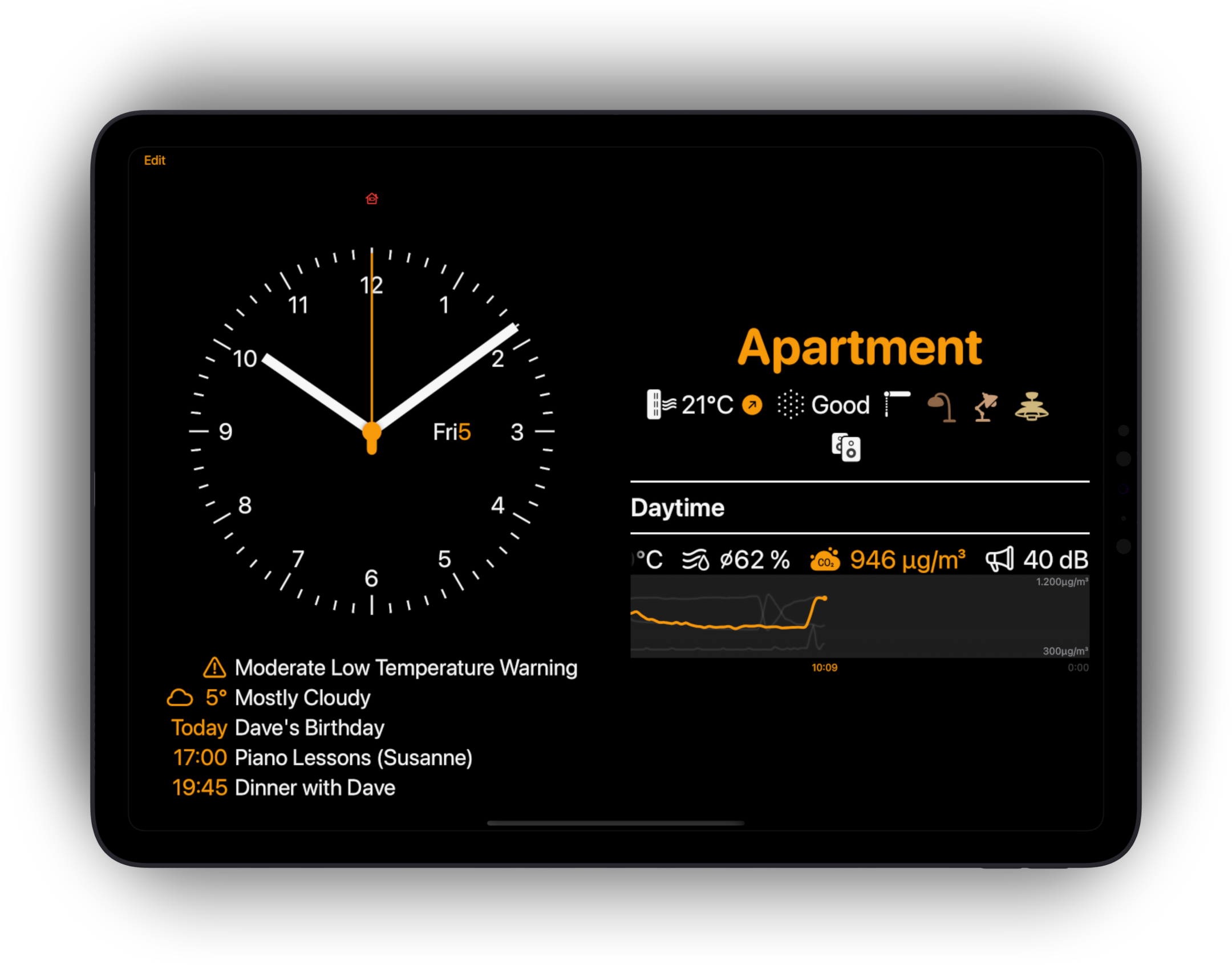Wallflower.
A control panel for your Apple Home.

Admit it: Nobody knows how to operate your smart home. You might have lots of apps on your phone to control everything, and you know what to shout at Siri, but does anyone else? You installed smart switches, but who knows what they do on a long-press or doubleclick? And if a smart home is about switches, what was the point of it the first place?
A better way to control your devices is an interactive display on the wall. For decades, established smart home vendors sold those as expensive custom hardware. Wallflower is an app that runs on a regular iPad or iPhone.
Like a very fancy lightswitch, Wallflower is designed to control the devices in the room it’s in. This enables a very compact interface: Only the devices that are on are being shown, all others are available with one extra tap. Data from multiple sensors is fused into one singular display.
Go beyond your Home
While the right side of the screen is dedicated to show what’s in your home, the left side shows everything else:
-
Display your family calendar in a convenient spot where everyone is actually looking!
-
The outside world can be full of surprises: Show the current weather, and see a little umbrella icon if you should take one. If there’s severe weather alerts, get alerted about it!
-
An always visible wall clock is still a very useful thing to have. This one is extremely accurate, shows the date and goes to a more compact digital display if you chose so or if space is tight.
-
Nobody wants to enter wifi passwords, so display a handy QR code for your guests that let them join your Wifi with the camera!
-
If anything goes wrong, Wallflower makes you see the issues: Unreachable devices, low batteries, etc. Nasty stuff.
The interface is optimized for being viewed from afar — most times you look at the app, you don’t actually interact with with it. So what you don’t need, is not shown. When you stand right in front of it, interactive elements reappear—even before you touch anything, the camera is used to sense your presence. Don’t worry: This feature is strictly opt-in and respects your privacy. No data is saved or sent anywhere for this, the image data is discarded immediately.
When the room gets dark, you don’t want the iPad to illuminate your home. iOS has built-in auto-brightness, but with long running applications such as Wallflower, it needs some help to do it’s job. If you opt in, the app uses the camera metadata to figure out if the room is dark and adjusts the light accordingly.
You aren’t the only person in your home: While Wallflower is designed for everybody to control your home, Wallflower protects its settings, so it’s only you who can configure it. Depending on your device, they can be protected with Touch ID, Face ID or Password. And if you leave the settings open accidentally, they’ll close automatically after a while.
Most important: Wallfower is part of your home, so it respects your privacy. That’s not an empty phrase: There is no tracking, no phoning home, no invasive 3rd party frameworks. It uses HomeKit, which runs locally, so it can even control your things when the internet is down. Where’s the catch? If you have a more complex setup, Wallflower is an app you pay for. But before you buy, you can try.
Great Power Comes With Great Compatibility.
Wallflower is based on Apples HomeKit platform. This means, everything you can get into Apps for Apple Home will be available in Wallflower. This includes major vendors like Philips, IKEA or Eve, Aqara and many other established companies. There are also bridges from other systems like KNX, and HomeBridge or Home Assistant supply a broad range of options with a DIY approach.
But as you might have heard, the future of smart homes is Matter. Currently, many Matter devices can just be added to HomeKit and are automatically supported by Wallflower. In the future it will probably be possible to support Matter directly without the restrictions of Apples HomeKit. No promises, but: Underneath everything, Wallflower is built with that in mind.
The best place for your home data is your home. Not your pocket.
You might have sensors for air quality, temperature, or humidity. Carbon dioxide levels in your home or office closely correlate with your ability to concentrate. You have an app that makes nice graphs of all that data, but each sensor has a different app, and you have to get your phone out of the pocket and start them?
Wallfower combines all data of a room into one graph: Different sensors from different vendors show their data in one combined view. So you can actually see what happens in the data when you open the window. How the room temperature and humidity changes, and how the air quality gets better. And it’s not only you who sees that, so does everybody else.
I want more!
- Read the FAQ.
- Get Wallflower on the App Store.
- Follow nxtbgthng on Mastodon, Bluesky or Twitter for updates.
